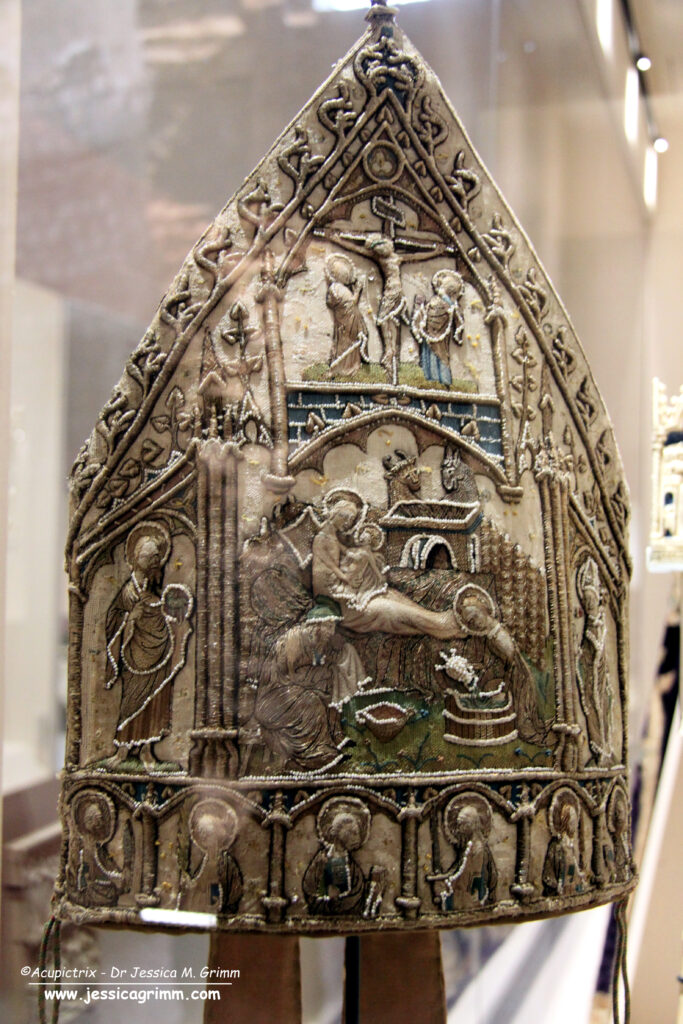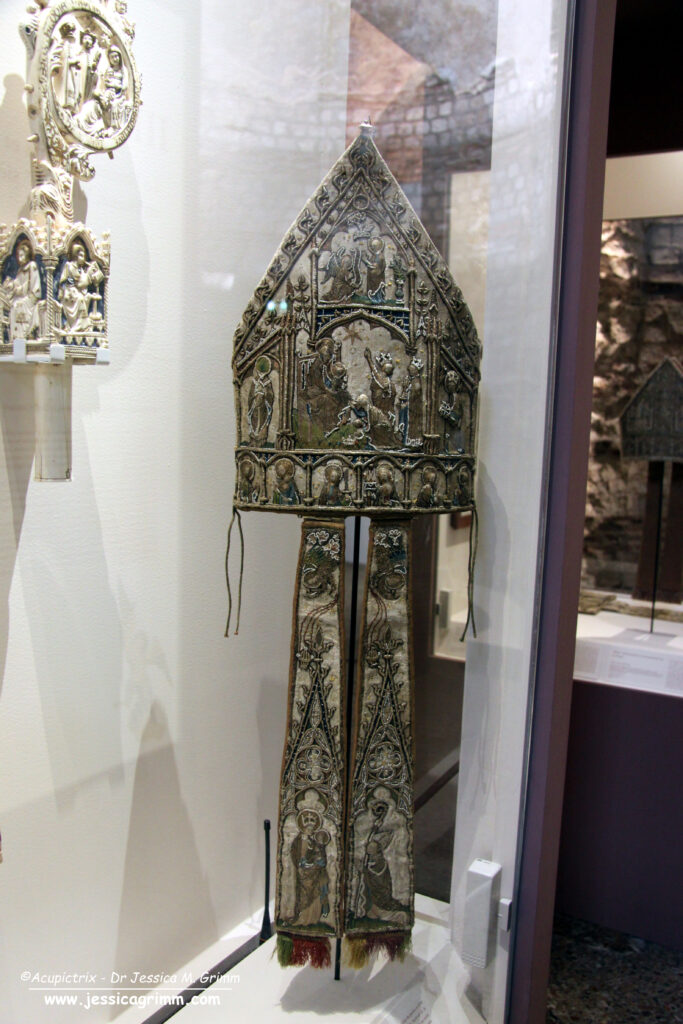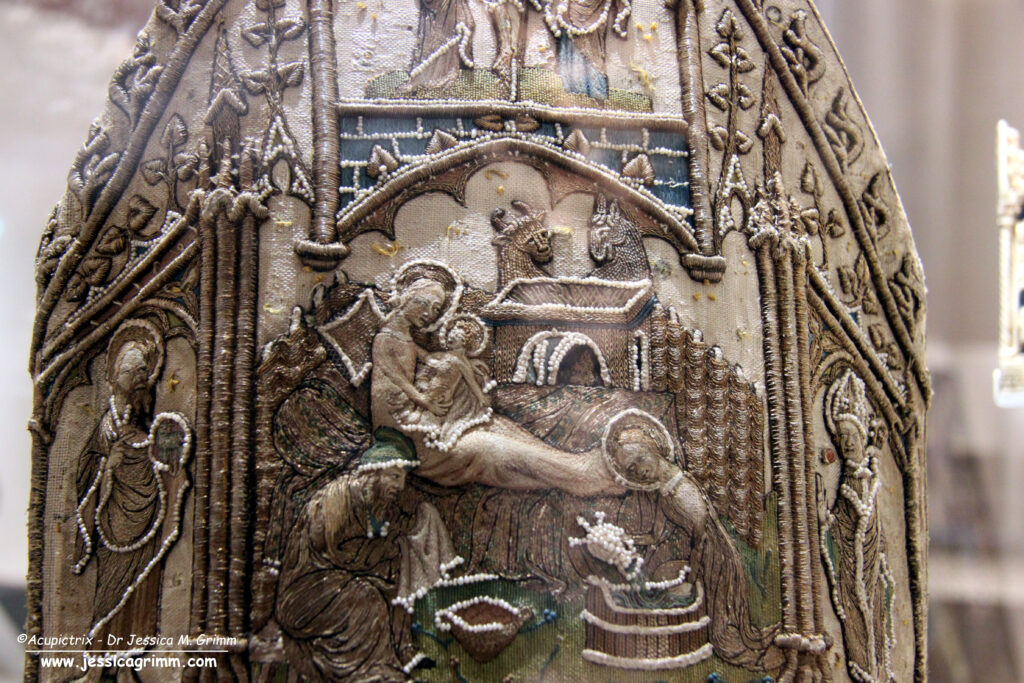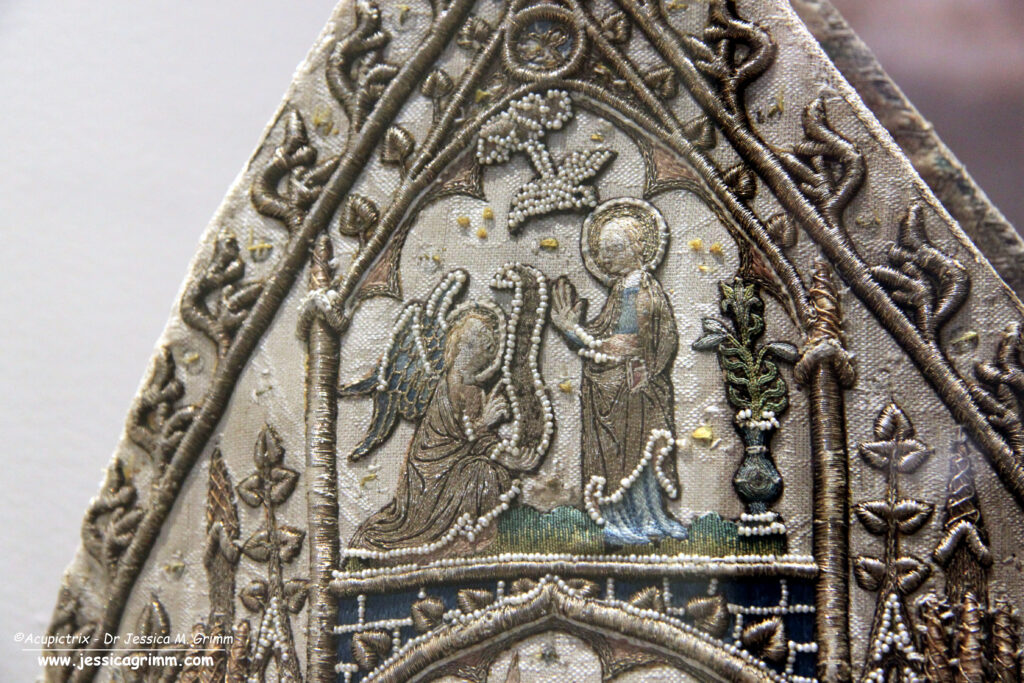Last week, we looked at the pearl-embroidered mitre of St Isidoro, which dates to the second quarter of the 14th-century. Today’s pearl-embroidered mitre is slightly younger and dates to the last quarter of the 14th-century and was likely made in Paris. It was once housed in Sainte-Chapelle, the 13th-century royal chapel in the heart of Paris (France). I was fortunate to see the mitre at the 2020 embroidery exhibition in Musée Cluny. The embroidery is very different in style and iconography compared to last week’s example. Let’s have a look!


On the front, the mitre shows the Nativity with the Crucifixion above. The saint on the left is John the Baptist, and there’s a sanctified bishop on the right. The Adoration of the Magi with the Annunciation above is shown on the back. The scenes are flanked by Denis of Paris (patron saint of Paris) and Catherine of Alexandria. The lappets show Mary with Child on one side and a bishop on the other. Censing angels are depicted above these figures. The bottom rim is decorated with bustes of the twelve Apostles.

The cutest scene on this mitre is the Nativity scene. Yes, there’s Mary with baby Jesus, and there’s the oxen and the donkey – classical components of a Nativity scene. But then there’s Joseph (left) drying a diaper by the open fire. And the maid on the right prepares a bath for baby Jesus. The design was inspired by the works of illuminator Jean Pucelle, who introduced this typical Italian iconography into French art.

The embroidery is high-end and would probably have stood under the king’s patronage. The frames around the scenes consist of string padding with gimped couched passing thread. The clothing of the figures is mainly stitched in couched passing thread. Pairs of gold thread have been couched down with a gold-coloured silken thread. The gold threads follow the flow of the garments. Undergarments, faces, and hands have been stitched in finely shaded split stitches. The stitch direction follows the drape of the garments and the shape of the facial features, just as in Opus anglicanum. Parts of the figures have been padded to give them some dimension.
Or nué, or shaded gold, has been used for the grassy background. The gold threads run strictly vertically. And everything has been lavishly embellished with freshwater pearls. From a church inventory from AD 1480, we know that the mitre was once also adorned with enamel plaques. There are also remnants of metal bezels that once held semi-precious stones. And do you see the tufts of yellow silk? That’s what is left of the stitches that once secured glass beads. How will you incorporate some bling into your embroidery today?
Literature
Blöcher, H., 2012. Die Mitren des hohen Mittelalters. Abegg Stiftung, Riggisberg.
Descatoire, C. (Ed.), 2019. L’art en broderie au moyen âge: Autour des collections du musée de Cluny. Musée Cluny, Paris.

The embroidery is so elaborate and detailed. Would parishioners typically have been close enough to the clergyman to actually see it? I’m not Catholic, but during the masses I have attended I definitely was not.
Good point, Vanessa! These things were not necessarily made for human eyes. The elaborate decoration was intended for God. And only the best things were good enough for God. That said, the bling did leave an impression on the parishioners, although they could not make out the details.
First of all: hope you are feeling better, Jessica!
It is really beautiful! So many lovely details.
And I do love pearls!! They make such a difference!
I have a question regarding: „ The frames around the scenes consist of string padding with gimped couched passing thread. “
1. what is „gimped couched“?
2. did they really turn the passing thread forward/backward when couching? It’s amazing how they managed to do it. The threads are so tight next to each other over the padding
Thank you!
Hi Dagmar! You can read all about gimped or guimped couching in the RSN Stitch Bank. This is a good resource for looking up embroidery stitches and techniques. https://rsnstitchbank.org/stitch/guimped-embroidery
Got it! Thank you Jessica! I wasn’t even aware that „gimped couching“ is a defined stitch. Again, learned something new! 😃
I just participated in the RSN stitch bank giveaway competition naming this stitch! Maybe I will win…..
That recalled the Sainte Chapelle to me very vividly. We visited maybe a decade ago, and it was breathtaking.
What I really like here is that beside learning about embroidery I also learn how to phrase and what vocabulary to use when trying to find the right words to express my admiration for the piece presented. I like „breathtaking“ very much! 🙂